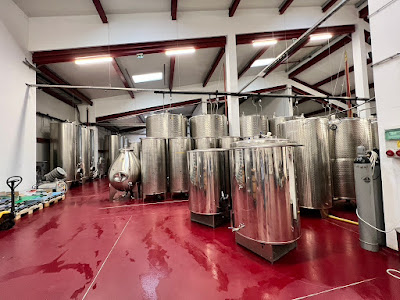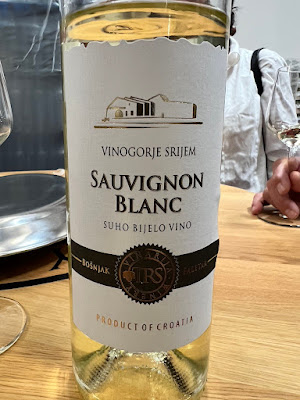Two friends, Zlatko (pictured above) and Marijo, had been making small amounts of wine, using purchased grapes, but they were desirous of having more control one the process. They wanted to own their own vineyards, and did so, although initially they began making wine separately, a total capacity of 30K liters. They eventually realized they might do better working together, so they united in 2003 and founded the TRS cooperative winery in 2007. Trs roughly translates as "vine." This new winery increased their capacity to 80K liters and owned 29 hectares of vineyards.
Since that time, the cooperative has significantly grown so now that it includes sixteen members, 70 hectares, and the total capacity is about 550K liters, although annual production is only about 300K-350K liters. Their production is about 70% white wine and 30% red. Their white grapes include Graševina, Chardonnay, Rhine Riesling, Traminac, Sauvignon Blanc and Muscat Blanc while their red grapes include Frankovka, Cabernet Sauvignon and Cabernet Franc.
The original wine building at their location is from 1885, with a wine cellar from the 18th century. In 2009, when they purchased the winery, they renovated the historic building and have plans for the wine cellar as well. They want to build a tunnel between the two wine cellars.
They only produce about 2,000 bottles per year of premium wines. Most of their wine exports are to Bosnia and they have even established a company in Bosnia to handle the trade.
The 18th century wine cellar entrance is on the left side of the photo.
We got to visit the old wine cellar, which looks intimidating as you peer down the steps into the darkness. Tentatively, you walk down the steps, being careful not to fall, and you enter the darkness, using your cellphones as a light source. There is a sense of great age as you wander the darkened area, and you can see the potential for this cellar once it has some renovations.
Zlatko led us through a tasting of some of their wines, beginning with the 2021 Sauvignon Blanc, which was bright and fresh, with notes of lemon and citrus. An easy drinking wine, great for the summer.
We then moved onto some tank tastings of Graševina, a few from the 2021 vintage. There were definitely differences in the various tanks, even from the same vintage, especially as some were from different vineyards. The wines were generally quite good, with lots of potential. Graševina does so well in Slavonia.
We then moved onto some bottled wines, such as the 2020 Grasevina, which was fresh and bright, with delicious apple flavors, good acidity, and a pleasing finish. The 2015 Grasevina, with a 13% ABV, was intriguing with a more intense and deeper flavor, with less fruit notes, a hint of smoke, and a mild spice element. This is a wine that best works with food, and is also indicative of how well that Grasevina can age.
The 2018 3C is a wine that was originally created out of a mistake. Initially, they wanted to use Frankovka in this wine, and it took them five years to realize that the grape they were actually using was Carmenere, and not Frankovka. They decided to keep the Carmenere, and the wine became "3C", a blend of Carmenere, Cabernet Franc, and Cabernet Sauvignon. With a 14.5% ABV, this wine was delicious, with pleasant red fruit flavors, low tannins, good acidity and some nice complexity. The blend works so well, and is definitely more unique in Croatia. This is probably one of the only wineries that uses Carmenere in Croatia. Highly recommended.
The 2016 Cabernet Sauvignon, with a 15% ABV, was easy drinking and fruity (although not jammy) with restrained tannins. A good pizza and burger wine.
The 2017 Cabernet Franc. with a 15% ABV, impressed me once again, being big, bold, and intense, with a complex melange of red and black fruits with mild spice notes. The finish was lengthy and satisfying, and it would pair well with hearty dishes or a nice steak. Highly recommended.













No comments:
Post a Comment